by amgranger | May 4, 2017
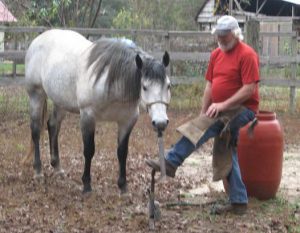
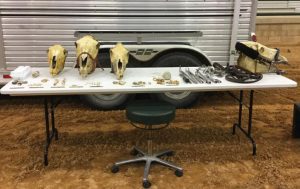 The Area A 4-H Horse Advisory Committee is pleased to welcome Dr. Bess Darrow, DVM and Mr. Billy Blackman, Professional Farrier to our first Area A 4-H Equine Clinic. Our focus will be on overall equine health, as well as dental and hoof concerns. There is no fee for this clinic but you must register on Eventbrite by June 5th. Lunch is provided for current 4-H members.
The Area A 4-H Horse Advisory Committee is pleased to welcome Dr. Bess Darrow, DVM and Mr. Billy Blackman, Professional Farrier to our first Area A 4-H Equine Clinic. Our focus will be on overall equine health, as well as dental and hoof concerns. There is no fee for this clinic but you must register on Eventbrite by June 5th. Lunch is provided for current 4-H members.
After the workshop, participants may make appointments and bring their horses to have dental and hoof work done. *Fees will apply. To make appointments you will need to contact Dr. Darrow or Mr. Blackman personally (see flyer for contact information.)
The Area A Horse Advisory Committee is planning a series of both educational and competitive events for youth enrolled in the 4-H Horse and “Horse-less” Horse Projects this coming 4-H year! For more information about the Florida 4-H Horse Program, contact your local UF/IFAS County Extension Office or visit one of these links:
Florida 4-H Horse Project Page
Florida 4-H Horse Events (UF IFAS Animal Sciences)
by Niki Crawson | Apr 25, 2017
The month of April brings one of my favorite times of the year. We have the Easter Bunny showering us with treats on Easter and the Earth dancing on its axis for Earth Day. Pick any type of towering tree for Arbor Day and then there are a gazillion funny pranks and jokes to be told for April Fool’s Day. Add a week to highlight the wonderful generosity of volunteers giving in organizations around the world and you have one fabulous month of the year! That’s right! April dedicates a week each year, National Volunteer Appreciation Week, to recognizing and celebrating individuals that give of themselves to help others.

Kim Gilbert is a 4-H volunteer that values both the impacts she makes and receives from being involved in 4-H.
To help the month of April highlight our NW District’s large green family of fabulous 4-H volunteers, let me introduce you to one of my 4-H volunteers befitting of April, 4-H, volunteering, and bunnies, oh my! Meet Kim Gilbert, a Holmes County 4-H Volunteer, who has been the Rabbiteers Club Leader for the past two years. With two daughters in 4-H of her own, she is a true example of a 4-H parent, volunteer, and supporter. Kim fully supports the idea of 4-H being a big family and continually emphasizes this point in her 4-H club meetings. She believes in 4-H’s essential elements and strongly stresses belonging and generosity with her club members. As Kim explains, “You become a big family when you join 4-H and you can count on everyone to help out and pitch in. I love my 4-H family!”
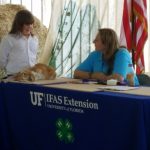
Chloe, learned to show her rabbit before a judge in a local 4-H fair.
Kim is always full of enthusiasm, encouragement, and new ideas that she shares with the youth and their rabbits. Armed with a soft rabbit in each arm and usually sweets for each club member too, Kim hops off to get her club meeting started. With a background in raising, breeding, and judging rabbits, Kim is knowledgeable in a variety of rabbit breeds including Holland Lops, English Lops, Polish, Lionheads, Angoras, and Giant Angoras. Not raised in 4-H as a child herself, she is thankful that she is able to provide 4-H opportunities to her own daughters and also give back by volunteering through leading the 4-H Rabbiteer Club. Since Kim’s involvement with the Rabbiteers, Holmes County 4-H youth have learned how to participate in showmanship in local rabbit shows and fairs. When not leading club meetings, Kim will often times volunteer to work on exhibits and events to help staff and other clubs.
When asked which of the 4 H’s best represented her, i.e. Head, Heart, Hands, or Health, Kim stated that was actually a very hard question. As a 4-H Agent who has worked closely with her for two years, I had no doubt which one represented her immediately but I patiently waited for her own reply with a secret smile on my face. After a moment, Kim replies, “I would say it is a tie between Hand and Heart but if I had to choose, I guess I will go with Heart.” Without a doubt, she nailed the answer perfectly! Kim is definitely one that is always thinking of others first, whether it is a simple note of well wishes or a thoughtful goodie bag of treats for each youth. She leads the youth and other adults with her heart and demonstrates the role of a 4-H club leader very well, truly encompassing the passion that was founded when 4-H adopted the motto “to make the Best Better.”
Kim is a true advocate of 4-H, firmly believing that not only does she positively impact youth as a 4-H volunteer but that she is being impacted by the organization as well.
According to Kim, “4-H has totally impacted my life in a way that I would not have seen two years ago. It has changed the way I look at things, how I handle things and has also taught me more things about my own self. 4-H has also brought my own family closer, learning to share more with each other.” Ah, there’s that generosity component we 4-Hers love to spread so much!

Hop on over to http://florida4h.org/volunteers_/ to join our 4-H family!
With truly caring volunteers in our 4-H family, it’s no wonder that 4-H is one of the nation’s largest youth development organizations in the world. If you are not a 4-H volunteer yet, what is stopping you? Hop on over to our website at http://florida4h.org/volunteers_/ to join our 4-H family as a volunteer! We have something for everyone!
by Melanie Taylor | Apr 24, 2017
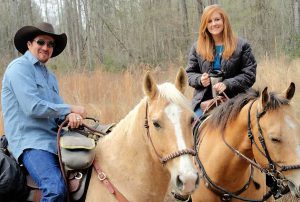
Russell and Julie McMillian, Gulf County 4-H Alumnae and 4-H Leaders
Russell and Julie McMillian both grew up in Gulf County and together have established a thriving business based on their love of horses. They now own a small farm in Dalkeith, just south of Wewahitchka, and their business Rockin’ M Ranch, consists of horseback riding lessons for beginners and beach rides for tourists and locals alike along the beautiful beaches of Cape San Blas.
How did this all begin? Russell and Julie both grew up as Gulf County 4-H members of the Big River Riders 4-H Club. They both participated in a variety of 4-H programs; including Horse Camp, Camp Timpoochee, Congress (now known as 4-H University), District Events, North Florida Fair Ag Judging, Area A and State 4-H Horse Shows, etc. They both learned the values of 4-H through learning how to raise and compete with their animals, agricultural commodities, leadership skills, public speaking, community service, good decision making skills, and much more…
As adults, they both went in separate directions, but still maintained their love of horses and the farm life. Russell began his career in flooring and tile work, while Julie received her education degree and taught Kindergarten at Wewahitchka Elementary School. After reconnecting as adults, they married on September 25, 2010 and turned their passion for horses into a full-time love by creating their own business, Rockin’ M Ranch. Russell still does flooring, tile work on the side, and helps his grandparents with their hay business. Julie decided to leave the teaching field, and she manages their business full time. She began giving beach rides on the Cape at the age of 14 and still loves it as much today.
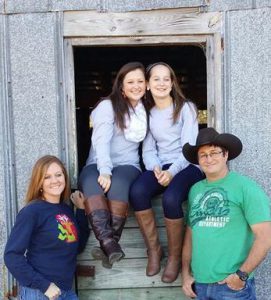
Julie and Russell McMillian pictured with Brooke (left) and Hayleigh (right).
Russell began his time with 4-H at the age of 12 and Julie was 8 years old. As members of the Big River Riders 4-H Club, they adored their 4-H leaders, Mr. Jesse Eubanks and Ms. Jean McMillian (Russell’s grandmother), and the Gulf County Extension Director, Roy L. Carter (now retired), whose passion for horses was contagious. Julie explained that she was a very shy child and that participating in public speaking for District Events really helped her come out of her shell. They both loved learning the values of the four H’s: Head, Heart, Hands, and Health. They feel 4-H has helped them develop into productive adults with good decision-making skills and in-stilled in them the importance of giving back to their community. They have served as 4-H volunteers for the Big River Rider’s 4-H Club since Russell’s daughters joined 4-H years ago; Brooke (17) and Hayleigh (15) also ride horses and have competed in a variety of Gulf County 4-H programs throughout the years. Russell and Julie have also taught a variety of horse riding classes at multiple Gulf County 4-H day camps.
As 4-H and community leaders, their most important goal is to give back to the community that gave to them as 4-Hers growing up here. They really love introducing new riders to the love of horses and 4-H. On any day, Russell and Julie can be found throughout the county at various events supporting 4-H members and any youth for that matter.
When asked what advice she has for someone thinking about becoming a 4-H volunteer she said, “Do not have regrets…just do it. Do not be scared off by the fingerprinting and application process. It is quick and easy, and maintains the safety for you and the children. Get started! 4-H is a great opportunity for youth and adults.”
“As a 4-H extension agent, you can only hope to find 4-H volunteers as dedicated as Russell and Julie McMillian. Their passion and love of 4-H is infectious and draws in youth looking for a place to belong.” -Melanie Taylor, Gulf County 4-H Agent
For more information about Rockin’ M Ranch, please go to http://www.therockinmranch.com/. For more information about how to become involved in 4-H, either as a youth member or adult volunteer, visit florida4h.org or contact your local UF IFAS County Extension Office. 4-H offers a variety of roles for volunteers to share their passions, skills and interests.
by Monica Brinkley | Apr 14, 2017
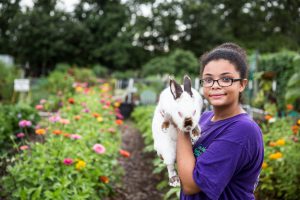
Rabbits are a popular small animal project- but is it a good fit for your family?
With spring in the air, you may be interested in getting a real live bunny. There are a few things to consider before bringing a bunny into your family:
- First consider what purpose you have for the rabbit. Do you want a pet, a rabbit to show, a rabbit to breed, or one for meat? Depending on how you answer the question will depend on what breed you choose. There are many options. The American Rabbit Breeders Association recognizes around 47 different breeds.
- Rabbits come in various sizes, shapes, fur types, and colors. Rabbit range from 2 to 20 pounds. There are several fur types to consider with normal fur being most common to unique fur that require special consideration. Satin fur is known for its luster and sheen. Angora fur is distinctive because of its length and its woolen consistency. Rex fur is a dense fur type, noted for its velvet softness and thickness.
- There are five shapes of rabbits: commercial, compact, full arch, semi-arch, and cylindrical. The most common is the commercial shape. This type is found most often in meat rabbits. The compact is similar to the commercial but has a shorter, more compact body. A rabbit that has a full arch shape is taller than they are wide and have longer limbs. Semi-arch breeds are not as common, are pear-shaped. The cylindrical shape is only found in only one bread, are long and slender.
- Rabbits have an array of color. Some breeds are only recognized in one color and other breeds are recognized in multiple colors. It would be helpful for you to spend time reading about the different breeds as well as spending time with breeders or others who have rabbits. Make sure you look for healthy and lively rabbits who have glossy coats, clear, bright eyes, and clean teeth and ears.
- Rabbits are fun to keep buy need lots of care and daily exercise. They need a roomy cage to in live. Do not use a cage with a wire bottom as the wire hurts their paws. Cages should be washed out once a week with warm, soapy water and rinsed with clean water. Rabbits are like us, they don’t like living in dirty cages. Remove wet bedding and droppings every day. Keep unscented wood shavings in the bottom of the cage. They should have fresh water and hay available at all time. Food should be put in heavy bowls so that they cannot tip them over and fed two small meals a day. Wash their water bottle and food bowls every day.
- Rabbits can be a lot of fun as they are friendly and love to be stroked. You must be a good pet owner and learn to look after your rabbits properly, they may live for up to 10 -12 years. Caring for a rabbit will help you learn how to be responsible for a living animal and how to treat animals properly.
Check with your local 4-H office to see if there is a rabbit club for you to join. You may choose to join the club to become more knowledgeable about rabbits before you become an owner. You then would be able to make informed decision about the perfect breed for you and your family. If you have a passion for rabbits, consider becoming a 4-H rabbit project leader to inspire the next generation of rabbit owners and breeders. Contact your local UF IFAS County Extension Office or visit florida4h.org for more information.
4-H Rabbit Project Page
Online 4-H Rabbit Project Book
North Florida Fair Rabbit Show
by Melanie Taylor | Mar 23, 2017
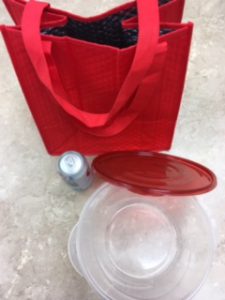
Do you remember the 3 R’s? If you are over the age of forty you are probably thinking of a classroom, a teacher, and learning about Reading, wRiting, and aRithmetic. These are the basic standards for learning, of course. However, it is now 2017and the 3 R’s have a new meaning to a new generation of young people: Reduce, Reuse, Recycle!
In today’s society, we constantly hear concerns about the environment and how we need to implement changes to make a positive impact upon its future. It is nearly impossible to pay attention to any media without feeling bombarded by messages of conservationism. “Go Green!” “Green… it’s the new black.” “Reduce, Reuse, Recycle.” However, are these sentiments new? Think about it. “Give a Hoot… Don’t Pollute.” “Keep America Beautiful.” “Keep Our Forests Green.” The use, or abuse, of our natural resources has long been an issue debated by our nation. It has more or less been the price we have had to pay for progress; but regardless of one’s political views and beliefs, the fact that Earth is the only planet that will sustain human lives is a hard fact to deny. It is therefore critical that all of promote principles of conservationism for our future generations.
The practice of reducing, reusing, and recycling may be easily incorporated into many aspects of your everyday lives. As YOU reduce, reuse, and recycle in your daily lives, you will be teaching by example your own children at home. Knowing that youth learn by seeing and doing, they will be much more likely to implement the practices of reducing, reusing and recycling into their own daily lives if they see you practicing the 3 R’s in yours.
How does the Environmental Protection Agency describe each of the 3 R’s? Reduce the amount and toxicity of trash you throw away. One way is to turn off or unplug lights during the day. Doing so will save energy and help your lights last longer. Use food scraps, yard trimmings, and other organic wastes to create a compost pile. Adding the compost you make to soil increases water retention, decreases erosion, and keeps organic materials out of landfills. Reuse containers and products. There are many creative ways to reuse items, which might normally find their way into the waste stream: old shoeboxes may be used for storage, plastic containers for planters, etc. You can also donate or give away items rather than throwing these items away. For a large number of unwanted items, you can hold a garage sale. It is also encouraged to shop at garage sales before buying new!
Recycle as much as possible and buy products with recycled content. Recycling includes collecting, sorting and processing certain solid waste into raw materials for re-manufacture into new items. These all help to cut down on the amount of waste we throw away. They conserve natural resources, landfill space and energy.
In addition, the three R’s save land and money communities must use to dispose of waste in landfills.These are all things we can do daily with just a little thought and effort. In fact, businesses are making it easier for us every day. We can reduce our trash in many ways, but an easy way is to reuse water bottles instead of throwing them away after each use. We can use the reusable bags that many stores now offer for our purchases; this is a great alternative to using plastic shopping bags. Of course, we can all make more of an effort to recycle by collecting our newspapers, aluminum cans, plastic bottles and glass jars for local recycling centers. If there are not recycling centers in your area maybe you should start one or pursue your community leaders about the importance of having one.
A few points to consider…
- The average American produces about 4.5 lbs. of garbage per person per day. This equal 235 million tons a year.
- Recycling 1 ton of paper saves 17 mature trees.
- Recycling 1 aluminum beverage can saves enough energy to run a 100 watt light bulb for 20 hours, a computer 3 hours, or a TV for 2 hours. (Currently, 45% of aluminum cans are recycled.)
- Reduce and reuse by donating old clothes and items to charities.
By instilling the importance of the 3 R’s into today’s society we will be helping clean the planet for the future. After all, “A true conservationist is a man who knows that the world is not given by his fathers but borrowed from his children.” As quoted by John James Audubon. Our state 4-H service project theme for next year is the environment. Why not consider planning a club, county or district service learning project in honor of Earth Day?
Source:
United States Environmental Protection Agency , https://www.epa.gov
by jgl1 | Mar 3, 2017
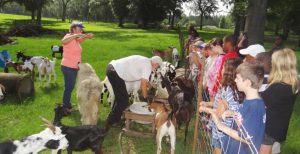
Fred and Bobby teaching a group of 4-Hers about goats.
Fred and Bobbie Golden relocated to Jefferson County from Lakeland, Florida in 2000 to establish Golden Acres Ranch LLC. The sixty-three-acre ranch is home to one of the largest mayhaw ponds in the region, grass fed goat & sheep, free-range chickens, guineas, pet boarding, and a country store.
Bobbie and Fred have genuine love for Jefferson County 4-Hers. Can you tell the difference between a sheep and a goat? Jefferson County 4-H campers can! For the past six years, 5-8 year old youth visited their ranch during 4-H day camps for some hands-on learning about agriculture. The campers have opportunities to feed, pet and learn important facts about Tennessee Fainting Goats, sheep, Pyrenees and Maremma, chicken, guineas and other animals reared on the farm.
Abagail Loveless, day camp participant said, “the reasons I like to visit Golden Acers Ranch, you get to feed, pet, learn things about the farm animals and swing on the tire/rope. “London Skipworth indicated that she was afraid of chickens, but with help and support from teen counselors and 4-H Staff, she was able to overcome her fears. London now plans to participate in the 4-H Chick Chain Project this year.
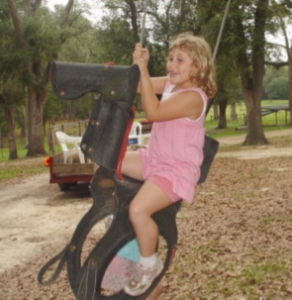
After a day of farming, Abigail enjoys a tire swing
Bobbie Golden, said “I like inviting the campers to the ranch because I like teaching them interesting facts about our farm animals, but most importantly bringing the youth back in touch with agriculture.”
Bobbie is a member of the Jefferson County Extension Ag Advisory and Vice President of the Overall Extension Advisory Committee. Bobbie also chaired the Extension Office open house committee. Bobbie and Fred support Jefferson County Extension in every capacity.
Annually, Jefferson County Extension participates in the Millstone Farm Tour and the Mayhaw Festival; both held events at Golden Acers Ranch. Each Extension program area provides interactive displays and hands activities for the youth and adults. For more information about Golden Acres Ranch, please go to https://goldenacresranchflorida.com/.
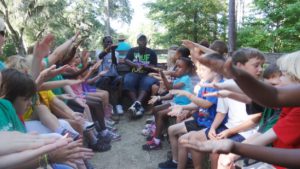
Campers leading songs on a hay ride around the farm.

 The Area A 4-H Horse Advisory Committee is pleased to welcome Dr. Bess Darrow, DVM and Mr. Billy Blackman, Professional Farrier to our first Area A 4-H Equine Clinic. Our focus will be on overall equine health, as well as dental and hoof concerns. There is no fee for this clinic but you must register on Eventbrite by June 5th. Lunch is provided for current 4-H members.
The Area A 4-H Horse Advisory Committee is pleased to welcome Dr. Bess Darrow, DVM and Mr. Billy Blackman, Professional Farrier to our first Area A 4-H Equine Clinic. Our focus will be on overall equine health, as well as dental and hoof concerns. There is no fee for this clinic but you must register on Eventbrite by June 5th. Lunch is provided for current 4-H members.









